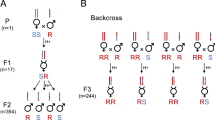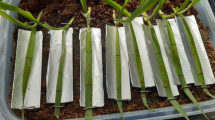Abstract
Resistance and tolerance are considered to be different plant strategies against disease. While resistance traits prevent hosts becoming parasitized or reduce the extent of parasitism, tolerance traits reduce the fitness-impact of parasitism on infected hosts. Theoretical considerations predict that in some circumstances mutual redundancy will give hosts with either high resistance or high tolerance a fitness advantage over hosts that exhibit both of these traits together. However, empirical evidence has provided mixed results. In this paper, I describe the pattern of phenotypic selection imposed by the holoparasitic mistletoe Tristerix aphyllus upon resistance (spine length) and tolerance (branching) traits in the cactus Echinopsis chilensis. Results indicate that branching was an efficient compensatory mechanism, reducing 75.5% of the fitness-impact attributable to parasitism. Even though both traits showed a negative correlation, as expected from the presence of allocation costs between strategies, no correlational selection coefficient was significant indicating that selection did not favor alternative combinations of traits. Consequently, I did not find evidence for selection promoting mutually exclusive defense strategies against the mistletoe, which suggests that tolerance and resistance traits may coexist stably in populations of E. chilensis.
Similar content being viewed by others
References
Agrawal, A.A., Strauss, S.Y. and Stout, M.J. (1999) Costs of induced responses and tolerance to herbivory in male and female fitness components of wild radish. Evolution 53, 1093-1104.
Agrawal, A.A. (2000) Overcompensation of plants in response to herbivory and the by-product benefits of mutualism. Trends Plant Sci. 5, 309-313.
Ballabeni, P. (1995) Parasite-induced gigantism in a snail: a host adaptation? Funct. Ecol. 9, 887-893.
Bentler, P.M. (1995) EQS Structural Equations Program Manual. Multivariate Software, Inc. Encino, California, USA.
Bergelson, J. and Crawley, M.J. (1992) The effects of grazers on the performance of individuals and populations of scarlet gilia, Ipomopsis aggregata. Oecologia 90, 435-441.
Botto-Mahan, C., Medel, R., Ginocchio, R. and Montenegro, G. (2000) Factors affecting the circular distribution of the leafless mistletoe Tristerix aphyllus (Loranthaceae) on the cactus Echinopsis chilensis. Rev. Chil. Nat. Hist. 73, 525-531.
Burdon, J.J. (1987) Diseases and Plant Population Biology. Cambridge University Press, Cambridge, Massachusetts, USA.
Byrne, B.M. (1994) Structural Equation Modeling with EQS and EQS/Windows: Basic Concepts, Applications and Programming. Sage Publications, Thousand Oaks, California, USA.
Campbell, D.R., Waser, N.M., Price, M.V., Lynch, E.A. and Mitchell, R.J. (1991) Components of phenotypic selection: pollen export and flower corolla width in Ipomopsis aggregata. Evolution 45, 1458-1467.
Cody, M.L. (1984) Branching patterns in columnar cacti. In N.S. Margaris, M. Arianoustou-Farragitako and W.C. Orchel (eds). Being Alive on Land. Tasks for vegetation studies, Vol. 13. W. Junk, The Hague, The Netherlands, pp. 201-236.
Cody, M.L. (1986) Structural niches in plant communities. In J. Diamond and T.J. Case (eds). Community Ecology. Harper & Row, New York, USA, pp. 381-405.
Coleman, J.S., McConnaughay, K.D.M. and Ackerly, D.D. (1994) Interpreting phenotypic variation in plants. Trends Ecol. Evol. 9, 187-191.
Conner, J.K., Rush, S., Kercher, S. and Jennetten, P. (1996) Measurements of natural selection on floral traits in wild radish (Raphanus raphanistrum). II. Selection through lifetime male and total fitness. Evolution 50, 1137-1146.
Crespi, B.J. (1990) Measuring the effect of natural selection on phenotypic interaction systems. Am. Nat. 135, 32-47.
Crespi, B.J. and Bookstein, F.L. (1989) A path-analytic model for the measurement of morphology. Evolution 43, 18-28.
Dunn, G., Everitt, B. and Pickles, A. (1993) Modelling Covariances and Latent Variables using EQS. Chapman & Hall, London, UK.
Fineblum, W.L. and Rausher, M.D. (1995) Tradeoff between resistance and tolerance to herbivore damage in a morning glory. Nature 377, 517-520.
Gibson, A.C. and Nobel, P.S. (1986) The Cactus Primer. Harvard University Press, Cambridge, Massachusetts, USA.
Gotelli, N.J. and Moore, J. (1992) Altered host behavior in a cockroach-acanthocephalan association. Anim. Behav. 43, 949-959.
Haukioja, E. (1991) The influence of grazing on the evolution, morphology and physiology of plants as modular organisms. Philos. T. Roy. Soc. Lond. B 333, 241-247.
Hechtel, L.J., Jonhnson, C.L. and Juliano, S.A. (1993) Modification of antipredator behavior of Caecidotea intermedius by its parasite Acanthocephalus dirus. Ecology 74, 710-713.
Juenger, T. and Bergelson, J. (1997) Pollen and resource limitation of compensation to herbivory in scarlet gilia, Ipomopsis aggregata. Ecology 78, 1684-1695.
Juenger, T. and Bergelson, J. (2000) The evolution of compensation to herbivory in scarlet gilia, Ipomopsis aggregata: herbivore-imposed natural selection and the quantitative genetics of tolerance. Evolution 54, 764-777.
Karban, R. and Baldwin, I.T. (1997) Induced Responses to Herbivory. University of Chicago Press, Chicago, USA.
Kuijt, J. (1969) The Biology of Parasitic Flowering Plants. University of California Press, California, USA.
Lande, R. and Arnold, S.J. (1983) The measurement of selection on correlated characters. Evolution 37, 1210-1226.
Lively, C.M. (1999) Migration, virulence, and the geographic mosaic of adaptation by parasites. Am. Nat. 153, S34-S47.
Lobuc, C. and Bell, M.A. (1993) Phenotypic manipulation by the cestode parasite, Schistocephalus solidus, of its intermediate host, Gasterosteus aculeatus, the threespine stickleback. Am. Nat. 142, 725-735.
Maad, J. (2000) Phenotypic selection in hawkmoth-pollinated Plantanthera bifolia: targets and fitness surfaces. Evolution 54, 112-123.
Marquis, R.J. (1996) Plant architecture, sectoriality and plant tolerance to herbivores. Vegetatio 127, 85-97.
Martinez del Río, C., Hourdequín, M., Silva, A. and Medel, R. (1995) The influence of cactus size and previous infection on bird deposition of mistletoe seeds. Aust. J. Ecol. 20, 571-576.
Maschinski, J. and Whitham, T.G. (1989) The continuum of plant responses to herbivory: the influence of plant association, nutrient availability, and timing. Am. Nat. 134, 1-19.
Mauricio, R. and Rausher, M.D. (1997) Experimental manipulation of putative selective agents provides evidence for the role of natural enemies in the evolution of plant defense. Evolution 51, 1435-1444.
Mauricio, R., Rausher, M.D. and Burdick, D.S. (1997) Variation in the defense strategies of plants: are resistance and tolerance mutually exclusive? Ecology 78, 1301-1311.
Mauseth, J.D., Montenegro, G. and Walckowiak, A.M. (1984) Studies of the holoparasite Tristerix aphyllus (Loranthaceae) infecting Trichocereus chilensis (Cactaceae). Can. J. Bot. 62, 847-857.
Mauseth, J.D., Montenegro, G. and Walckowiak, A.M. (1985) Host infection and flower formation by the parasite Tristerix aphyllus (Loranthaceae). Can. J. Bot. 63, 567-581.
Medel, R. (2000) Assessment of parasite-mediated selection in a host-parasite system in plants. Ecology 81, 1554-1564.
Mitchell, R.J. (1992) Testing evolutionary and ecological hypotheses using path analysis and structural equation modelling. Funct. Ecol. 6, 123-129.
Moore, J. (1983) Responses of an avian and its isopod prey to an acanthocephalan parasite. Ecology 64, 1000-1015.
Mouritsen, K.N. and Jensen, K.T. (1994) The enigma of gigantism: effect of larval trematodes on growth, fecundity, egestion and locomotion in Hydrobia ulvae (Pennant) (Gastropoda: Prosobranchia). J. Exp. Mar. Biol. Ecol. 181, 53-66.
Musselman, L.J. and Press, M.C. (1995) Introduction to parasitic plants. In M.C. Press and J.D. Graves (eds). Parasitic Plants. Chapman & Hall, London, UK, pp. 1-13.
Ness, J. and Foster, S.A. (1999) Parasite-associated phenotype modifications in threespine stickleback. Oikos 85, 127-134.
Nobel, P.S. (1980) Interception of photosythetically active radiation by cacti of different morphology. Oecologia 45, 160-166.
Nobel, P.S. (1981) Influences of photosythetically active radiation on cladode orientation, stem tilting, and height in cacti. Ecology 63, 982-990.
Norton, D.A. and Carpenter, M.A. (1998) Mistletoes as parasites: host specificity and speciation. Trends Ecol. Evol. 13, 101-105.
Núñez-Farfán, J. and Dirzo, R. (1994) Evolutionary ecology of Datura stramonium L. in central Mexico: natural selection for resistance to herbivore insects. Evolution 48, 423-436.
Paige, K.N. (1992) Overcompensation in response to mammalian herbivory: from mutualistic to antagonistic interactions. Ecology 73, 2076-2085.
Paige, K.N. and Whitham, T.G. (1987) Overcompensation in response to mammalian herbivory: the advantage of being eaten. Am. Nat. 143, 739-749.
Poulin, R. (1994) Parasite manipulation of host behaviour: should hosts always lose? Oikos 70, 479-484.
Poulin, R. and Thomas, F. (1999) Phenotypic variability induced by parasites: extent and evolutionary implications. Parasitol. Today 15, 28-32.
Rausher, M.D. (1992) The measurement of selection on quantitative traits: biases due to environmental covariances between traits and fitness. Evolution 46, 616-626.
Rausher, M.D. and Simms, E.L. (1989) The evolution of resistance to herbivory in Ipomoea purpurea. I. Attempts to detect selection. Evolution 43, 563-572.
Rosenthal, J.P. and Kotanen, P.M. (1994) Terrestrial plant tolerance to herbivory. Trends Ecol. Evol. 9, 145-148.
Roy, B.A., (1993) Floral mimicry by a plant pathogen. Nature 362, 56-58.
Roy, B.A. and Kirchner, J.W. (2000) Evolutionary dynamics of pathogen resistance and tolerance. Evolution 54, 51-63.
Schluter, D. (1988) Estimating the form of natural selection on a quantitative trait. Evolution 42, 849-861.
Shonle, I. and Bergelson, J. (2000) Evolutionary ecology of the tropane alkaloids of Datura stramonium L. (Solanaceae). Evolution 54, 778-788.
Shykoff, J.A., Bucheli, E. and Kaltz, O. 1997. Anther smuth disease in Dianthus silvester (Caryophyllaceae): natural selection on floral traits. Evolution 51, 383-392.
Shykoff, J.A. and Kaltz, O. 1998. Phenotypic changes in host plants diseased by Microbotrym violaceum: parasite manipulation, side effects, and trade offs. Int. J. Plant Sci. 159, 236-243.
Silva, A. and Martinez del Río, C. (1996) Effects of the mistletoe Tristerix aphyllus (Loranthaceae) on the reproduction of its cactus host Echinopsis chilensis. Oikos 75, 437-442.
Simms, E.L. and Rausher, M.D. (1989) The evolution of resistance to herbivory in Ipomoea purpurea. II: natural selection by insects and costs of resistance. Evolution 43, 573-585.
Simms, E.L. and Triplett, J. (1994) Costs and benefits of plant responses to disease: resistance and tolerance. Evolution 48, 1973-1985.
Stamp, N. (1981) Behavior of parasitized aposematic caterpillars: advantageous to the parasitoid or the host? Am. Nat. 118, 715-725.
Stowe, K.A. (1998) Experimental evolution of resistance in Brassica rapa: correlated response of tolerance in lines selected for glucosinolate content. Evolution 52, 703-712.
Stowe, K.A., Marquis, R.J. Hochwender, C.G. and Simms, E.L. (2000) The evolutionary ecology of tolerance to consumer damage. Annu. Rev. Ecol. Syst. 31, 565-595.
Strauss, S.Y. and Agrawal, A.A. (1999) The ecology and evolution of plant tolerance to herbivory. Trends Ecol. Evol. 14, 179-185.
Thompson, J.N. (1994) The Coevolutionary Process. University of Chicago Press, Chicago, USA.
Thompson, J.N. (1999) Specific hypothesis on the geographic mosaic of coevolution. Am. Nat. 153, S1-S14.
Tiffin, P. and Rausher, M.D. (1999) Genetic constraints and selection acting on tolerance to herbivory in the common morning glory Ipomoea purpurea. Am. Nat. 154, 700-716.
Tuomi, J., Nilsson, P. and Åström, M. (1994) Plant compensatory responses: bud dormancy as an adaptation to herbivory. Ecology 75, 1429-1436.
van der Meijden, E., Wijn, M. and Verkaar, H.J. (1988) Defense and regrowth, alternative plant strategies in the struggle against herbivores. Oikos 51, 355-363.
Vance, S.A. (1996) Morphological and behavioural sex reversal in mermithid-infected mayflies. P. Roy. Soc. Lond. B Bio. 263, 907-912.
Yan, G., Stevens, L. and Schall, J.J. (1994) Behavioral changes in Tribolium beetles infected with tapeworm: variation in effects between beetle species and among genetic strains. Am. Nat. 143, 830-847.
Author information
Authors and Affiliations
Rights and permissions
About this article
Cite this article
Medel, R. Assessment of correlational selection on tolerance and resistance traits in a host plant–parasitic plant interaction. Evolutionary Ecology 15, 37–52 (2001). https://doi.org/10.1023/A:1011966329939
Issue Date:
DOI: https://doi.org/10.1023/A:1011966329939




